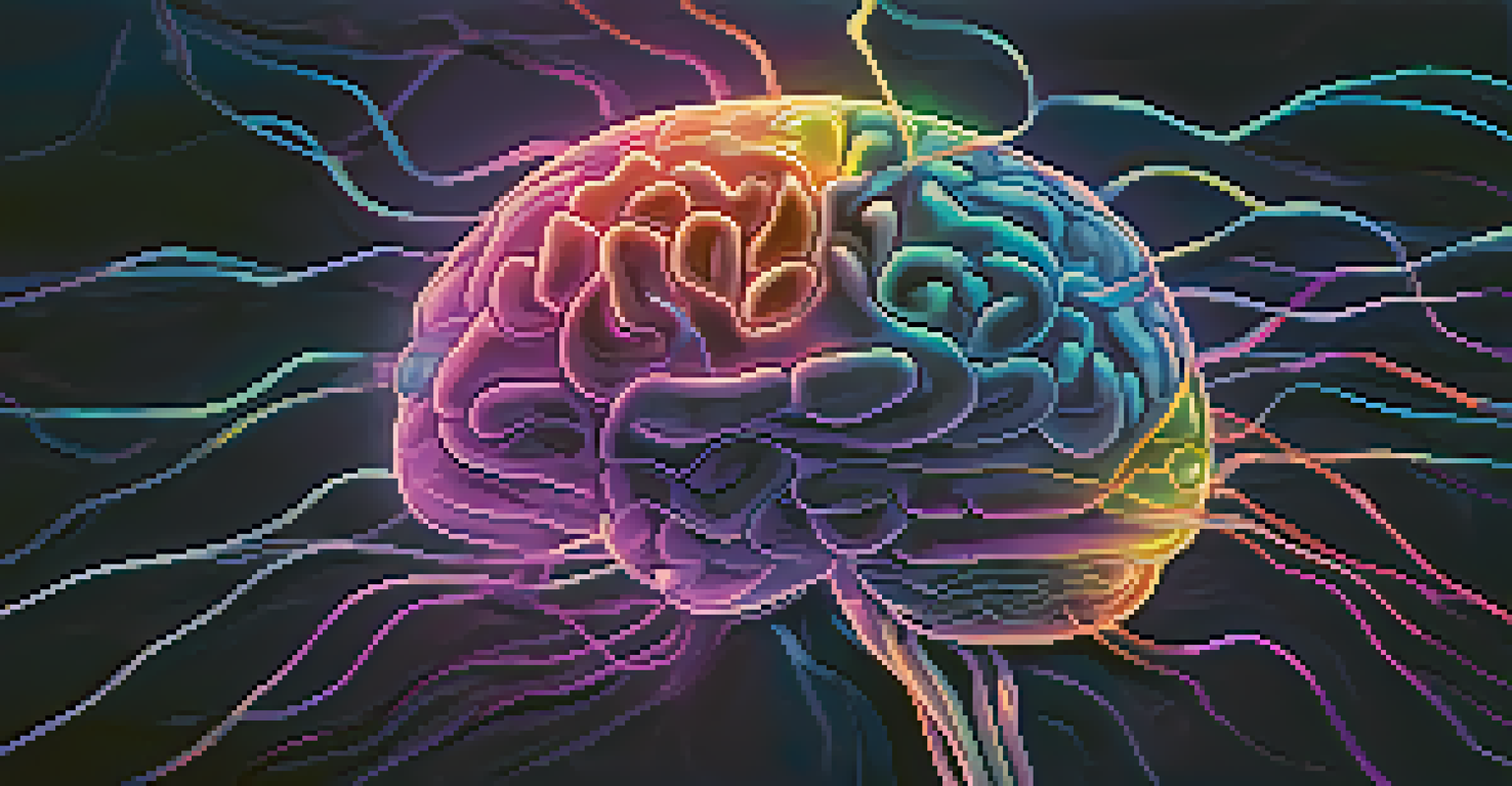Entheogens and the Brain: Mapping Visionary Experiences

What Are Entheogens and Their Historical Context?
Entheogens are psychoactive substances used in spiritual and religious contexts. Historically, cultures around the world have utilized these natural compounds, such as psilocybin mushrooms and ayahuasca, to induce altered states of consciousness. These experiences are often described as profound, connecting individuals with a sense of the divine or the universe.
Psychedelics, in a way, allow us to see the world as it is, not as we perceive it to be.
The term 'entheogen' itself means 'generating the divine within,' emphasizing the spiritual aspect of these substances. In ancient societies, shamans and spiritual leaders would guide individuals through these experiences, using them for healing and self-discovery. This rich history highlights the integral role of entheogens in human culture and spirituality.
As we explore their impact on the brain today, it’s essential to understand that these substances are not merely recreational. They have been revered for their potential to facilitate deep personal insights and transformative experiences that can lead to lasting changes in perception and understanding.
How Entheogens Interact with Brain Chemistry
Entheogens primarily affect the brain's neurotransmitter systems, particularly serotonin. Many of these substances mimic serotonin, binding to its receptors and altering mood, perception, and cognition. This interaction can lead to vivid hallucinations, altered thoughts, and an intensified sense of interconnectedness with the world.

For instance, psilocybin, found in magic mushrooms, is converted in the body to psilocin, which directly binds to serotonin receptors. This binding can enhance visual and auditory perception, resulting in a tapestry of colors and sounds that many users describe as overwhelmingly beautiful. Understanding this biochemistry provides insight into why these experiences can feel so profound.
Entheogens and Spirituality
Entheogens are psychoactive substances historically used in spiritual contexts to facilitate profound personal insights and connections with the divine.
Additionally, the brain regions activated during these experiences, such as the default mode network (DMN), are associated with self-reflection and the sense of ego. Disruption of the DMN might explain the feeling of ego dissolution—an experience many users report during their journeys with entheogens.
The Role of Neuroplasticity in Visionary Experiences
Entheogens not only induce immediate visionary experiences but may also promote neuroplasticity—the brain's ability to reorganize itself by forming new connections. This process is crucial for learning and adaptation and can be particularly beneficial for individuals dealing with trauma or mental health issues. The insights gained during entheogenic experiences can lead to lasting changes in thought patterns and emotional responses.
The mind is like a parachute. It doesn't work if it is not open.
Research has shown that substances like MDMA and psilocybin can enhance neuroplasticity, suggesting that they might help individuals reframe traumatic memories or negative thought loops. This potential for healing and transformation is one of the most exciting areas in the study of entheogens and their effects on the brain.
Thus, the visionary experiences facilitated by entheogens might not only provide immediate revelations but also pave the way for long-term cognitive and emotional benefits. This dual impact makes them a fascinating topic for both scientific study and personal exploration.
Visionary Experiences: What Do They Feel Like?
Individuals often describe visionary experiences under the influence of entheogens as deeply transformative and life-altering. Users report feelings of unity with nature and the universe, heightened sensory perception, and even encounters with what they describe as higher beings or spirits. These experiences can range from blissful and enlightening to challenging and introspective.
Many people find that during these journeys, their understanding of reality and self shifts dramatically. For example, someone may feel as though they are dissolving into their surroundings or experiencing time in a nonlinear fashion. Such profound experiences can lead to a newfound appreciation for life and often inspire individuals to make significant changes in their lives.
Therapeutic Potential of Entheogens
Recent studies suggest that entheogens may effectively treat conditions like PTSD and depression by promoting emotional breakthroughs and cognitive shifts.
This emotional intensity is not just anecdotal; studies have found that many report lasting positive changes in their perspectives and lifestyles after these experiences. It's this combination of emotional depth and cognitive insight that makes entheogens so captivating in today’s discussion about mental health and personal growth.
The Therapeutic Potential of Entheogens
Recent studies have highlighted the therapeutic potential of entheogens, particularly in treating conditions like PTSD, depression, and anxiety. As traditional treatments often fall short for many individuals, these substances offer a new avenue for healing by facilitating profound personal insights and emotional breakthroughs. The experiences can help patients confront and process their traumas in a safe environment.
For instance, clinical trials with psilocybin have shown promising results in significantly reducing symptoms of treatment-resistant depression. Participants report a sense of liberation from their mental health struggles, often attributing this to the insights gained during their sessions. This emerging evidence is encouraging researchers and clinicians to explore entheogens as viable therapeutic options.
However, it's important to approach this potential with caution. The set (mindset) and setting (environment) are crucial factors in ensuring the safety and efficacy of these experiences. Proper guidance and integration support are essential for individuals to navigate their experiences and implement their newfound insights effectively.
Challenges and Risks of Entheogenic Use
While there are many potential benefits to entheogenic substances, it's essential to acknowledge the risks involved. Not everyone is a suitable candidate, and individuals with certain mental health conditions may experience adverse effects. For example, those with a personal or family history of psychosis may be at an increased risk of triggering such episodes during their experiences.
Additionally, the lack of regulatory oversight in the use of these substances can lead to unsafe practices. Consuming untested or contaminated substances can result in unpredictable and potentially dangerous outcomes. It’s crucial for users to educate themselves and approach entheogens with respect and caution.
Risks of Entheogenic Use
While entheogens offer potential benefits, they also carry risks, particularly for individuals with certain mental health conditions, necessitating informed and cautious use.
Ultimately, understanding these risks allows for a more informed and responsible engagement with entheogens. With the right knowledge and preparation, individuals can mitigate potential dangers and focus on the therapeutic and transformative aspects of their journeys.
The Future of Entheogens in Science and Society
The renewed interest in entheogens has sparked significant research and discussion within the scientific community. As more studies emerge confirming their safety and efficacy, there's a growing push to integrate these substances into mainstream therapeutic practices. This shift could revolutionize how we approach mental health treatment and personal growth.
Moreover, the dialogue surrounding entheogens is expanding beyond academia and into public consciousness. As society becomes more aware of the potential benefits, there's a movement towards decriminalization and responsible use, allowing for safer access and greater acceptance. This cultural shift may eventually lead to a reevaluation of legal frameworks surrounding these substances.

As we look to the future, the challenge will be to balance the enthusiasm for entheogens with responsible research and usage practices. The possibilities are vast, and with continued exploration, we may unlock even greater insights into the human experience and the mind.